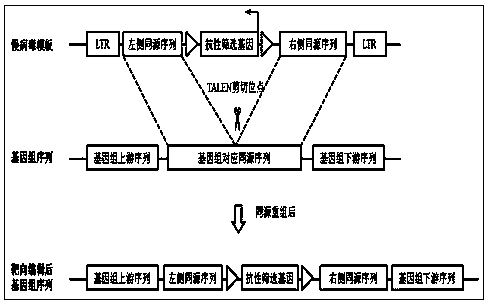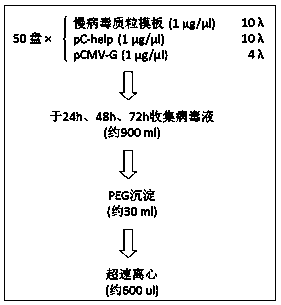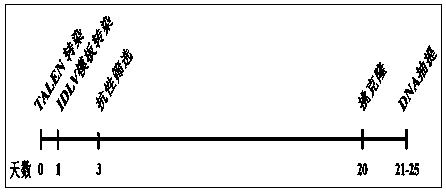Transcription activator-like effector nuclease (TALEN) target gene editing and optimizing method taking IDLV as template
A technology that targets genes and optimizes methods. It is applied in biochemical equipment and methods, genetic engineering, and plant gene improvement. It can solve the problems of difficult clone acquisition and screening, unsatisfactory results, and low efficiency of homologous recombination. Safety, the effect of not easy to insert mutagenesis
- Summary
- Abstract
- Description
- Claims
- Application Information
AI Technical Summary
Problems solved by technology
Method used
Image
Examples
Embodiment 1
[0035] Example 1 An optimization method for TALEN targeted gene editing using IDLV as a template
[0036] (1) TALEN design and construction: According to the target sequence for gene editing, the upstream and downstream specific TALENs were respectively designed through the online TALEN design website (https: / / tale-nt.cac.cornell.edu / ). The TALEN assembly plasmid kit was purchased from Addgene (CAT. #1000000016). The TALEN mammalian expression plasmid can be obtained by transforming the TALEN yeast expression plasmid pTAL3 or pTAL4 in the kit. The TALEN construction method was carried out according to the kit instructions and literature reports (Cermak, T., et al., Efficient design and assembly of custom TALEN and other TAL effector-based constructs for DNA targeting. Nucleic Acids Res, 2011. 39 (12): p. e82.);
[0037] (2) Construction of lentiviral plasmid template: Obtain homologous sequences of about 500 bp on both sides of the TALEN cut site of the target sequenc...
Embodiment 2
[0056] Example 2 Targeted gene editing optimization method of TALEN using IDLV as template for site-directed mutation of SMN2 gene
[0057] Spinal muscular atrophy (SMA) is an autosomal recessive genetic disease, clinically manifested as progressive degeneration of motor neurons in the anterior horn of the spinal cord, muscle weakness, atrophy, etc., and the incidence rate of newborns is about 1 / 10000. SMN1 gene defect is an important cause of SMA. The SMN2 gene is highly homologous to the SMN1 gene. Mutation of the sixth nucleotide T in exon 7 of the SMN2 gene to C can change the splicing site of the SMN2 gene transcription product, allowing the SMN2 gene to express the full-length SMN protein. Compensate for the SMN1 gene defect and play a role in disease treatment.
[0058] First, based on the SMN2 gene sequence, design the upstream and downstream TALEN target sequences (SEQ ID No: 1-2) that can specifically cause DNA double-strand breaks near the 6th nucleotide ...
Embodiment 3
[0059] Example 3 The TALEN targeted gene editing optimization method using IDLV as a template was used to carry out targeted correction of WAS gene mutation sites.
[0060] IVS6+5 G>A is a common gene mutation site in patients with WAS syndrome, located at the fifth nucleotide of the splicing donor site in intron 6 of the WAS gene. The point mutation at this position causes abnormal splicing of WAS transcripts, resulting in functional defects of WAS protein. Using targeted gene editing technology to correct this gene mutation will hopefully cure patients with WAS syndrome.
[0061] First, based on the WAS gene sequence, design TALENs (SEQ ID No: 11-12) that can specifically cause DNA double-strand breaks near IVS6+5, and use the Survey test to verify and evaluate the shearing efficiency of TALENs. Then design a homologous sequence (SEQ ID No: 13-14) based on the wild-type gene sequence near the IVS6+5 site of the WAS gene, construct a lentiviral plasmid template, an...
PUM
 Login to View More
Login to View More Abstract
Description
Claims
Application Information
 Login to View More
Login to View More - R&D
- Intellectual Property
- Life Sciences
- Materials
- Tech Scout
- Unparalleled Data Quality
- Higher Quality Content
- 60% Fewer Hallucinations
Browse by: Latest US Patents, China's latest patents, Technical Efficacy Thesaurus, Application Domain, Technology Topic, Popular Technical Reports.
© 2025 PatSnap. All rights reserved.Legal|Privacy policy|Modern Slavery Act Transparency Statement|Sitemap|About US| Contact US: help@patsnap.com



